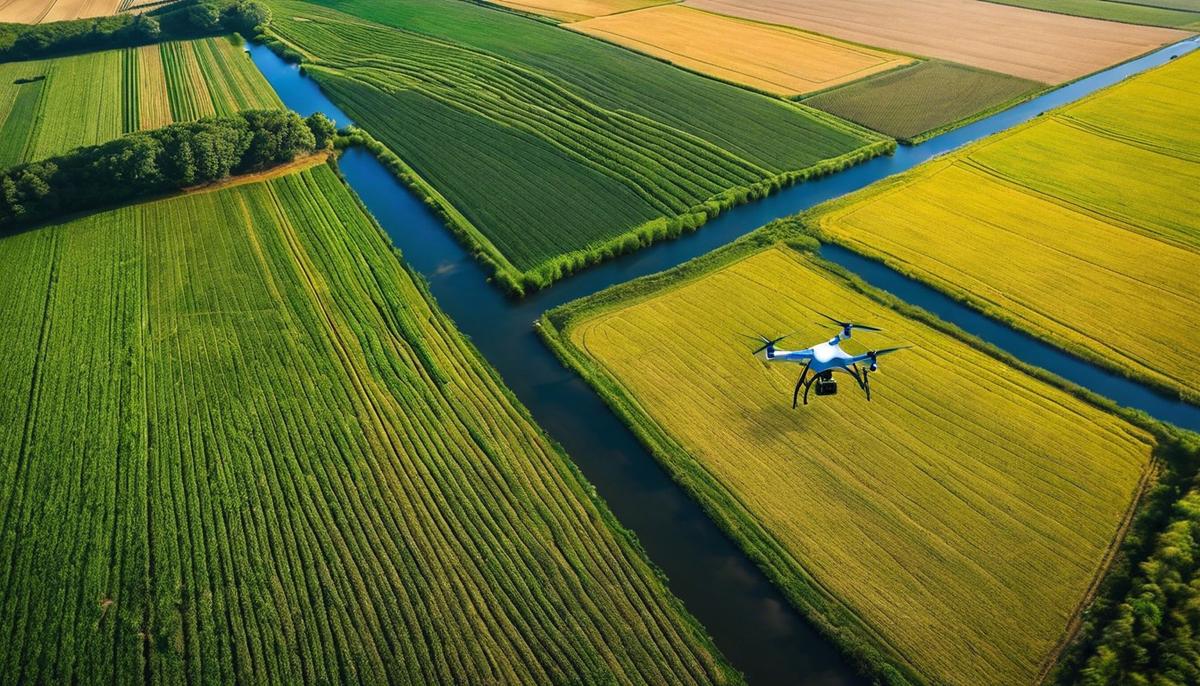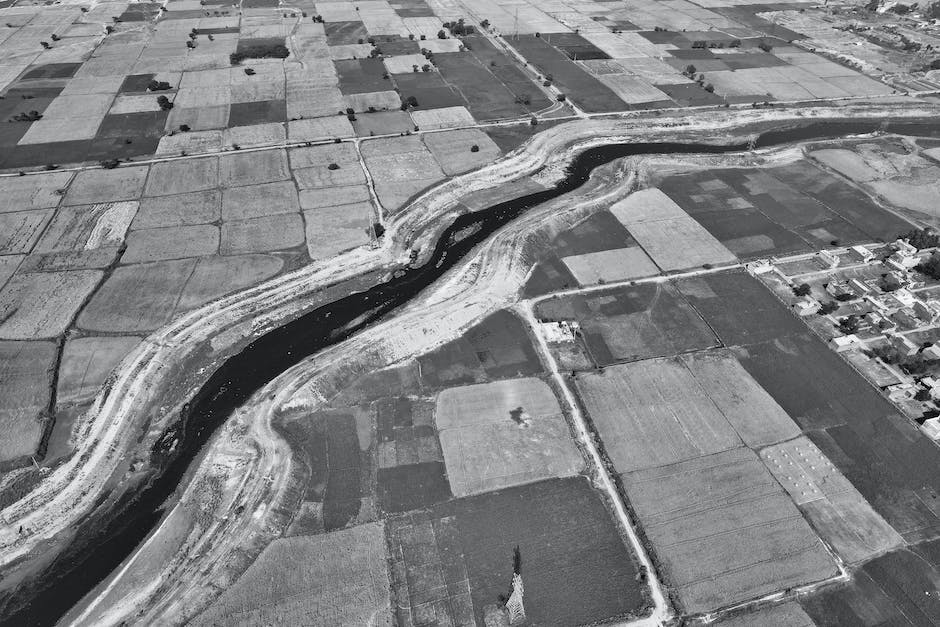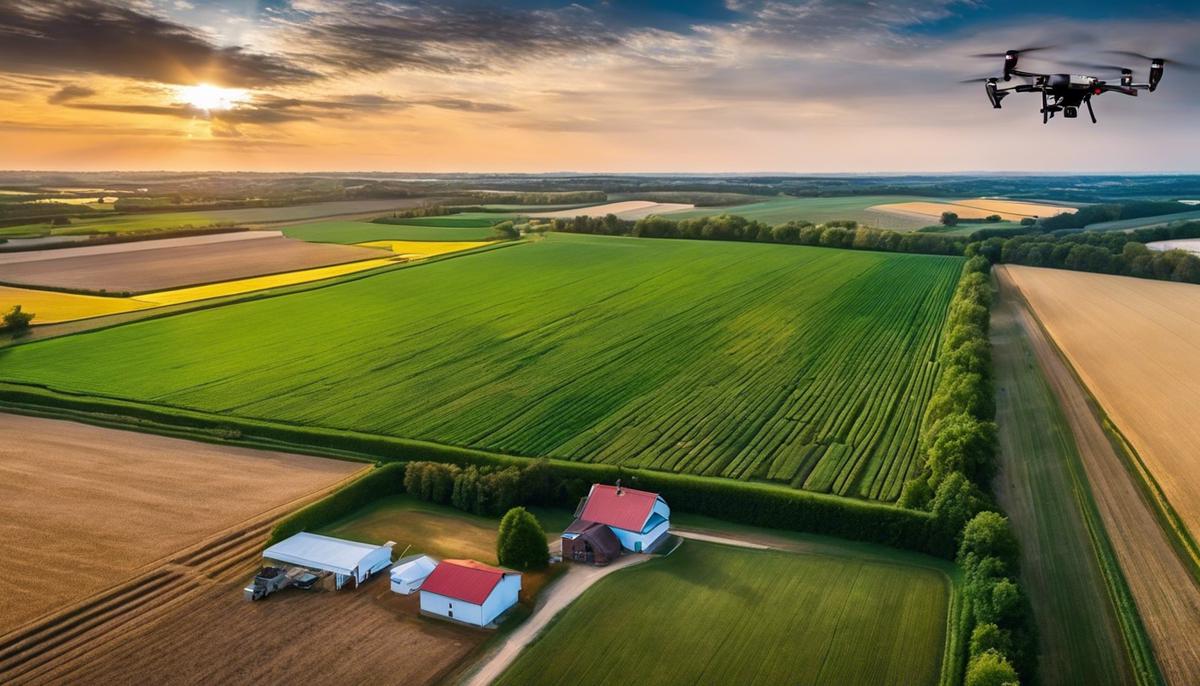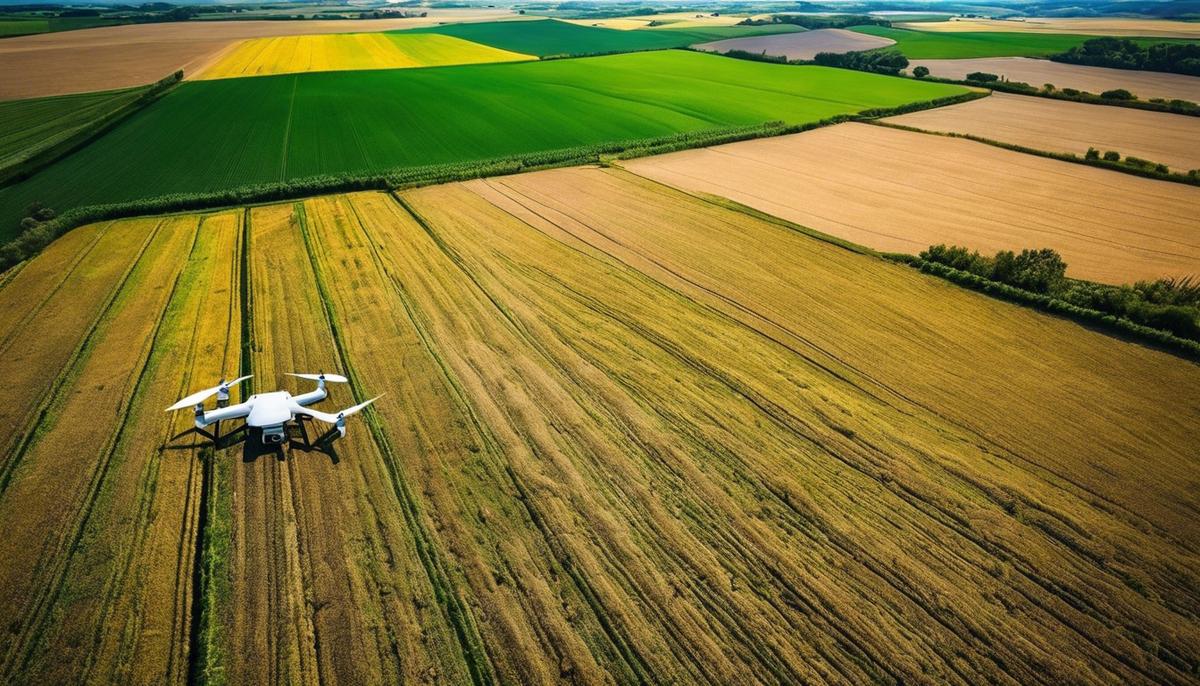

Agridisk
Egypt - Alexandria
.jpeg)
Drones for agricultural use | What type of drones can be used in agriculture?
Description: The past few decades have seen remarkable strides in technology, shaping several facets of society, among which agricultural practices have notably transformed. The evolution of drone technology and its incorporation into the agricultural sector marks one of these significant advancements. Providing a historical perspective on farming practices alongside the technological rise of drones sheds light on the profound effect this integration has had on that sector. This exploration addresses the technical elements that make up these farming aids, their broad applications, and the resultant impacts. Furthermore, we delve into the regulations and challenges that govern and influence the use of drones in agriculture, painting a multidimensional image of the promising future for this innovative technology. The emergence of Unmanned Aerial Vehicles (UAVs), commonly known as drones, has truly disrupted and transformed traditional agricultural practices. Revolutionizing the sector with their potential for precision agriculture, drones offer a high-tech makeover to conventional farming, enhancing productivity and sustainability. Initially, drones were popularly perceived to be military-grade technology or expensive playthings for tech enthusiasts. However, they have gradually been deployed as powerful tools in various fields, including agriculture, promising an array of applications that could transform the sector entirely. The foremost revolutionary change brought about by drones lies in their ability to provide high-resolution and real-time data. Equipped with cutting-edge sensors and imaging capabilities, drones can efficiently survey farmlands from a bird's eye perspective. This sophisticated form of aerial monitoring enables farmers to monitor crop health, track livestock, and assess environmental conditions with unprecedented detail and accuracy. Similarly significant is the drone's facilitation of precision agriculture. Prior to drone technology, farmers frequently carried out blanket treatments over entire fields, which could be both costly and inefficient. Now, using drones equipped with spectral imaging sensors, farmers can pinpoint specific zones of their fields that require attention. Such precision conserves resources and boosts yields, underscoring the immense agricultural advantage that drones offer. The integration of drones into agriculture has been an evolutionary process, with several significant milestones. The initial adopters were typically large-scale farming operations that could afford what was then a relatively expensive technology. Experimentation with drones began inconspicuously around 2006, when the first agricultural drones were equipped with basic GPS tracking systems and simple cameras. By 2010, this technology had progressed to include multispectral imaging sensors, which allowed for detailed vegetation analysis and identification of plant stress. The next major milestone was seen around 2015, when drones with near-infrared capabilities were introduced. This technology enabled farmers to measure crop health based on light reflection and absorption rates, thus further improving on-site precision. Following this, around 2018, advanced algorithm-based software was incorporated into drone systems, ushering in the era of artificial intelligence (AI) in agriculture. Such systems could not only collect data but analyze them, providing farmers with actionable insights to improve crop productivity and resource management. The fusion of drones and AI continues to push the frontier of potential in agriculture, particularly in the advent of autonomous drone systems. These innovative systems conduct operations autonomously, curating pathways, and making real-time adjustments without the need for human intervention, thereby introducing a new dimension of efficiency and accuracy to the world of agriculture. In conclusion, the drone revolution manifests a paradigm shift in agricultural practices, replacing traditional farming techniques with precision-driven solutions. The journey from rudimentary GPS-equipped drones to sophisticated autonomous systems reveals the remarkable pace and scope of this technological transformation. This evolution continues to impact global food production, promising a future where farming is smarter, more sustainable, and more efficient. The field of drone technology, as we already learned, presents significant potential to reformulate agricultural practices and operations. Notably, this transformative potential stems from key technological components integrated within this autonomous system. Such systems culminate in a harmonized ensemble, enhancing the efficacy, accuracy, and overall productivity of farming operations. Therefore, exploring these constituent elements and understanding their comprehensive functionalities provide a comprehensive pathway towards realizing the potential of drones in agriculture. One key component, sensors, plays a pivotal role in agricultural drone technology. Infrared (IR) sensors, LiDAR, multispectral sensors, and RGB sensors represent some of the fundamental sensing technologies harnessed. These sensors acquire data about various aspects of the crop environment, including plant health, crop density, moisture levels, and pest presence, among others. The data procured by these sensors is instrumental in assisting farmers' decision-making processes in terms of irrigation, fertilization, or pest control strategies, thus cutting down resource wastage and promoting smarter farming. Navigation systems form the lifeline of an agricultural drone, enabling it to execute complex tasks with surgical precision. Cutting-edge Global Positioning System (GPS) technology, coupled with geoinformation systems, controls the drone's precise routes, thereby optimizing in-field efficiency. For instance, a programmed drone can follow a predefined path, spraying fertilizer with perfect timing and accuracy, leaving minimal room for error – a significant leap from traditional, less precise methods. Importantly, one must pay heed to battery technology, which currently poses one of the greatest constraints to drone operations due to limited flight time. Therefore, developments in battery technology and power management systems are crucial, as they dictate the limits of a drone's capabilities, determining the extent of drone usage per charge, recharging speed, and the viability of deploying drones on large agricultural estates. Drone software unveils another aspect of agricultural drone technology where innovation thrives. Drone software consists of data analysis tools and flight controllers, handling the most intricate technical aspects of drone operation. This feature enables near-real-time data analysis, transforming the raw data collected by the sensors into actionable insights. Moreover, autonomous flight control systems in the software orchestrate the drone's navigation and operation with unerring proficiency. Last but not least, on-board cameras embolden the visual capability of drones. High-definition (HD) video cameras document and capture high-resolution imagery of the overall farmland, aiding surveillance, inspection, monitoring, and mapping. Farmers, thus, can non-invasively assess and monitor their crops, detecting potential anomalies from the comfort of their own office. In conclusion, every technological element integrated within an agricultural drone, from sophisticated sensors, navigation systems, battery technology, drone software, to on-board cameras, works cohesively, contributing to sharpened precision and efficiency in modern farming operations. While this drone revolution leaves a conspicuous impact on global food production, it is vital to note that such remarkable advancements in agriculture are just the dawn of myriad possibilities awaiting in the horizon of technological advancements. The advent of further highly sophisticated technologies will inevitably augment, diversify, and enhance agricultural practices – a testament to the incredible potential lying within the nuanced field of drone technology. Diving deeper into the applications of drones in agriculture, the facilitation of precision spraying stands forefront. Chemical application via traditional ground methods can be labor-intensive, while aerial application can lack precision, often leading to overutilization and wastage of resources. Drones, equipped with multispectral, hyperspectral, or thermal sensors, can identify areas of crop stress and deliver exact amounts of pesticide, herbicide, or fertilizer to specific plants at just the right time. This reduces costs, increases yield, and mitigates environmental impact — a clear boon for sustainable agriculture. Crop health assessment becomes another significant application of drones. The spectral imaging capabilities of drones allow the identification of diseases and pests earlier than traditional methods. By comparing the color of different plants and studying their thermal profiles, one can diagnose their health status, identify diseases, or spot the presence of pests. Armed with this data, farmers can swiftly undertake corrective actions, thus saving crucial time, minimizing losses, and ensuring higher productivity. Arguably, one of the most transformative applications of drone technology in agriculture has been its role in water resource management. Irrigation efficiency can be significantly improved with drones outfitted with thermal cameras. These devices can detect variations in evapotranspiration rates across a field, enabling the farmer to identify critical areas requiring more water. Moreover, drones can inspect irrigation equipment for leaks or malfunctions, drastically reducing water waste. Drone technology has also made significant strides in livestock management. Drones equipped with thermal imaging can monitor animal health and detect early signs of diseases. Furthermore, they can provide rapid and accurate herd accounting, prevent theft, and aid in recovering lost animals, thus enhancing the overall efficiency of livestock management. In the realm of sustainability, not only do drones enhance efficiency, but they also critically contribute to carbon management. Through geospatial analysis and photogrammetric mapping, drones can aid in better understanding and managing soil carbon sequestration processes. These advancements present an opportunity for farmers to contribute more effectively to climate solutions while enhancing soil fertility and productivity. Acceleration in plant breeding is another notable contribution of drones. By measuring various phenotypic characteristics with unprecedented precision, drones are reshaping plant breeding—allowing faster development and deployment of new varieties. This aspect is particularly relevant considering the increasing pressure on agricultural output due to burgeoning global population and changing climatic patterns. The agricultural drone landscape is expanding rapidly, driven by a host of spectacular innovations. Moving forward, the development and acceptance of this technology will be instrumental in solving the multifaceted challenges confronting the agriculture sector—helping to feed the world sustainably. In contemplating the phenomenon of agricultural drones, one is compelled to investigate the legal and regulatory parameters that shape this burgeoning field. Specifically in the United States, the Federal Aviation Administration (FAA) plays a significant role in controlling the operation of drones, or Unmanned Aircraft Systems (UAS) as officially designated. Certain regulations, such as the requirement for operators to keep the drone within line of sight, stand as potential obstacles to extensive commercial use. Strict flight restrictions, particularly those relating to altitude and operation over populated areas, tend to constrain the vast potential of agricultural drones. Agricultural drone operation also faces challenges beyond regulatory constraints. For instance, the integration of drone technology into traditional farming processes demands substantial modification of existing protocols, often necessitating significant investment and training. The susceptibility of aircraft to weather conditions further complicates operations, particularly in areas prone to inclement weather. Despite such hurdles, one observes a resolved pursuit of innovation, fueling visions of a future where drones seamlessly integrate with agricultural practices. Given the overarching imperative of boosting global food productivity, experts predict an increasingly pivotal role for drones in accomplishing this task. In the foreseeable future, one can expect agricultural drones to surpass mere data collection and evolve to perform a broader array of more complex tasks. Current research suggests a future where drones may be deployed on a mass scale to execute precision crop spraying, thus optimizing pesticide use and limiting the impact on surrounding ecosystems. Moreover, drone technology deployed for the monitoring and regulation of irrigation could profoundly increase water efficiency, ultimately leading to significant conservation of this essential resource. Moreover, the potential of drones to revolutionize livestock management and carbon management cannot be underestimated. Pilot projects involving the use of drones for real-time monitoring of livestock health parameters and tracking grazing patterns have already indicated high potential in this regard. Simultaneously, drones may facilitate improved soil health management, thus enhancing both productivity and sustainability of agricultural systems. Finally, agricultural technology stands at a precipice, with drones poised to accelerate the process of plant breeding and development considerably. Envisaging a future in which drones undertake selective cross-pollination or seed planting heralds a new era for genetic enhancement of crops and plant species. The challenges facing agricultural drone use, though formidable, only signify a nascent field ripe for exploration and refinement. The befitting trajectory encapsulates an intriguing blend of regulatory evolution, technological advancement, and innovative methodologies, evidently steering towards a revolution that bespeaks a promising future for drones in agriculture. The use of drone technology in agriculture has yielded tangible benefits, with drones playing a crucial role in boosting productivity, managing resources efficiently, and reducing the environmental footprint. Notwithstanding these advantages, its application has been met with several challenges, primarily legal and safety issues, which necessitates a pragmatic approach in regulating this sphere. Peering into the future of agricultural drones reveals a wealth of opportunities, underscoring the potential that this integration holds to revolutionize farming practices further. As ongoing research continues to develop and refine this technology, it is likely that drones will play an increasingly central role in the agricultural landscape of tomorrow. With the accelerating pace of technological advancement, new tools are reshaping the landscape of various industries, and agriculture is no exception. Among these innovations, drones or unmanned aerial vehicles (UAVs) have emerged as a game-changer in modern farming. This write-up seeks to explore the utilization of drones in agriculture, more specifically, the types, technological features, and their profound impact on agricultural productivity. From multi-rotor drones to fixed-wing drones, each type holds unique use cases in farming, influenced by various agricultural objectives and needs. With sophisticated technologies like GPS and GIS, multispectral imaging sensors, and 3D mapping, drones are carving a path toward precision farming, effective irrigation management, and meticulous crop monitoring. Further this noteworthy impact on farming efficiency and productivity, quantified through data-driven insights and case studies, denotes the transformative potential of drones in agriculture. Drones, colloquially known as Unmanned Aerial Vehicles (UAVs) have revolutionized the agriculture sector in countless ways, with their primary value augmenting traditional approaches for better accuracy, efficiency, and productivity. The spectrum of drones used within the agricultural domain vary substantially, with each design facilitating unique capabilities to address certain challenges. Let's cut to the chase and delve into the types of drones used in agriculture. These bear similarities to conventional airplanes in structure, and showcase longevity in terms of battery life and flight times. Perfect for capturing a broader perspective, fixed-wing drones can surveil extensive farm lands swiftly, providing insights about the larger picture related to crops' health or damages inflicted. The obvious choice for precision, multi-rotor drones float on spot facilitating detailed observation. These drones may lack in speed and endurance compared to their fixed-wing counterparts, but make it up with their ability to hover and carry out intensive inspections of specific plot sections, making multi-rotor drones ideal for short-range missions. A perfect blend of multi-rotor and fixed-wing drones; hybrid drones combine speed, endurance and precision. They take-off and land vertically, eliminating the need for a runway and can hover for a significant amount of time to carry out focused observations. Their compact size is exceptionally advantageous for navigating through smaller spaces and for stealth-like surveillance. Though a relatively new entrant, nano drones have potential for pest control and targeted crop monitoring. Tricoper drones are essentially a type of multi-rotor drone with three rotors instead of four or more. Because of their specialized design, they're more versatile and responsive to controls, making them ideal for maneuvering around complex agricultural obstacles like trees or buildings. It's clear that agricultural drones have come a long way from being sophisticated toys to becoming indispensable farm management tools. With progress in the realms of artificial intelligence and machine learning, the capabilities of these drones will only continue to enhance. In the years to come, agricultural drones would not just provide birds-eye view of the farm; they will start becoming key drivers in predictive analytics, offering a proactive approach in farming. In the context of modern farming and agriculture, drones manifest incredibly useful applications. However, selecting the correct drone type is as crucial as recognising the need for drone technology. Every farm is unique, and the selection of drone must align meticulously with the farm requirements to truly unlock the full potential of this technology. After all, in the rapidly digitizing world of agriculture, efficiency is not just about keeping up with the times, but also smart adoption and strategic implementation. The future begins on the farm. Foremost among these technological features is high-resolution imagery. Today's drones come equipped with state-of-the-art cameras that can capture detailed images of large expanses of farmland within a short span of time. A visual assessment of crops from bird’s eye view provides a wealth of information. It allows farmers to spot anomalies, identify symptoms of disease, detect stress in crops and assess overall plant health - thus enabling prompt, localized response. Talk about precision! In addition to cameras, modern drones are also outfitted with sensors such as multispectral sensors and LiDAR. Multispectral sensors are capable of capturing data across specific wavelength ranges, including beyond human-visible range. With this information, growers can assess plant health on a deeper level by understanding factors like chlorophyll concentration, plant water status, and biomass growth rates. On the other hand, Light Detection and Ranging (LiDAR) technology allows farmers to create 3D maps of their farms and gather data related to elevation or geological features. LiDAR technology is particularly handy in topography and soil property analysis, two vital factors in agriculture that directly influence crop yield. Beyond hardware, drone technology's effectiveness lies in the software. Advanced analytics software can synthesize collected data into actionable insights. Farmers can apply machine learning algorithms to historical data to predict crop yield, assess soil health, and even develop irrigation strategies. The availability of real-time data analysis and predictive modeling puts modern farmers in control like never before. Lastly, the trend of drones becoming more autonomous is critical in transforming the agricultural landscape. Enhanced GPS systems, self-flying abilities, obstacle detection, and avoidance capabilities allow drones to carry out extensive missions without constant human intervention. These autonomous features mean drones can cover wider areas with lesser effort and in less time – a factor of utmost importance in large-scale farming operations. However, it's important to note that while technological advancements are making agricultural drones more capable than ever, successful implementation requires awareness, adeptness, and the willingness to adapt. Farmers must understand the various facets of drone technology and know how to interpret and implement data to make informed decisions. All things considered, the efficacy of drones in agriculture is clear. They offer a potent combination of speed, precision, and data – a trifecta that has the potential to yield substantial productivity gains in agriculture. As technological capabilities continue to evolve, it's reasonable to expect drones to become increasingly common – and increasingly beneficial – in the agricultural sector. The future, as they say, is up in the air – and it appears to be buzzing with drones. Drones in agriculture aren't just a trendy tech toy—these unlikely agricultural heroes significantly streamline farmers' operations and amplify efficiency. Leveraging drones’ advanced technology, farmers can keep a finger on the pulse of their lands without lifting more than a finger. High-resolution imagery is of paramount importance to agricultural drones, achieved through advanced, impeccable sensors like multispectral sensors and Light Detection and Ranging (LiDAR) technology. Multispectral sensors capture data across specific wavelengths, helping to identify plant stress, crop disease, and irrigation issues, amongst others. LiDAR sensors aid in monitoring crop health and vigor by generating precise 3D models of the farmland—enabling the capture of crop height, plant count, and canopy volume measurements. Moving beyond rudimentary analytics, this captured data feeds into advanced analytics software. The power of real-time insights lies in the ability to act instantaneously, a reality now possible with the advent of this software. Thanks to this, farmers can make informed decisions about irrigation strategies, pest management, and yield prediction. Essentially, the farms of today wouldn't resemble what they used to merely a couple of decades back. An intriguing upcoming trend in the agriculture sector is the increasing autonomy of drones. Until recently, drones required significant human intervention, for piloting and operating. Now, advancing technology is enabling drones to perform a variety of tasks independently, including flying along predetermined paths, identifying problematic crop areas, and applying pesticides, amongst others. Autonomy is the future, and drones look set to spearhead this revolution in agriculture. It is, however, essential not to overlook the human element in this rapidly evolving landscape. Implementing these drones requires awareness of their capabilities, adeptness at operating and maintaining them, and adaptability to integrate them into existing farming operations. Training is necessary for farmers to make the most of this technology. However, the potential gains in productivity are staggering. For instance, precision farming using drones can lead to a 15% yield increase and a 20% reduction in fertilizer use, enhancing efficiency dramatically. Whether it is the remote-sensing drones sprinkling seeds in a perfectly spaced pattern or drones that capture data to feed into expansive artificial intelligence systems, one thing is clear: drones are changing agriculture — they are the vanguard of a technological revolution on the farm, reinventing our approach to productivity and efficiency in the sphere of modern agriculture. In a world wrestling with issues like food security and resource scarcity, the drone technology holds tremendous promise, and it is exciting to see what else it will unfold. With phenomenal advancements already visible in the field, drones have truly found their place in the sun — soaring over fields, catching the light of the new dawn in agriculture. Whether you’re a tech enthusiast or a farmer, the rise of drones in agriculture is a fascinating phenomenon to witness! As drones continue to chart impressive strides in the agricultural sector, it is important to evaluate their pros and cons. While they bring undeniable efficiency and productivity benefits, there may also be associated environmental implications, like noise pollution, that warrant attention. Moreover, one must also ponder the potential drawbacks of dependence on this technology, like the initial investment cost and the need for advanced skills for operation. However, given the significant benefits of reduced labor costs, improved crop yields, and increased responsiveness to agricultural challenges, it is safe to say that drones, with their varied types and advanced technological features, are set to be the cornerstone of agriculture in the coming years.Drones for agricultural use
Overview and Evolution of Agricultural Drones
The Drone Revolution: Transforming Traditional Agriculture Practices

Technological Components and Functions of Agricultural Drones
Delving into the Constituent Technological Elements of Agricultural Drones and their Impacts on Farming Processes

Applications and Impact of Agricultural Drones

Regulations, Challenges, and Future Directions of Agricultural Drone Use

What type of drones can be used in agriculture?
Types of Drones Used in Agriculture
Fixed-Wing Drones:
Multi-Rotor Drones:
Hybrid Drones:
Nano Drones:
Tricopter Drones:

Technological Features of Agricultural Drones
With the introduction and overview of drone types already addressed, it's high time to delve into the crux of the matter – the key technological features that make drones effective for agricultural use. A lot hinges on these features, they are the chief reasons drones have a transformative impact on agriculture.

The Impact of Drones on Agricultural Productivity
